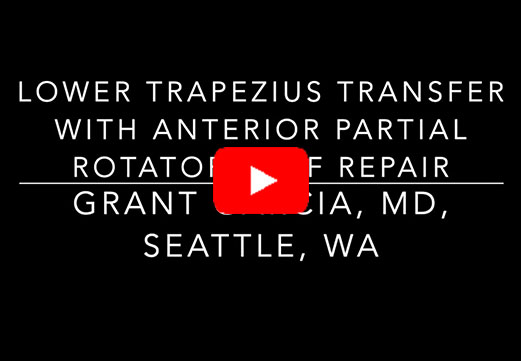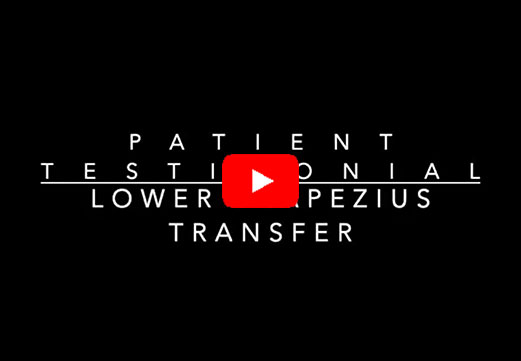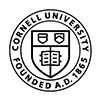Lower Trapezius Transfer
Dr. Garcia’s updated lower trapezius transfer technique

Anatomy
The trapezius muscle is a wide, flat and triangular muscle lying just beneath the skin covering the upper back of the shoulders and neck. It includes three parts: the upper trapezius, middle trapezius, and the lower trapezius. Lower trapezius tendon is the last part of the trapezius muscle that is attached to your shoulder blade (scapula). It helps in rotating the shoulder and twisting the arm. A rotator cuff is a group of muscles and tendons that holds the shoulder joint in place and allows movement of the arm and shoulder.
Lower Trapezius Transfer with Partial Cuff Repair
Background
Unfortunately, some rotator cuff tears are so bad or have been torn so long that they are not repairable. In this case more complex repairs are necessary. Dr. Garcia specializes in complex rotator cuff repair and has cutting edge techniques to salvage these injuries if possible. In many cases patients are unable to lift their arms and this can be very debilitating from a functional and pain standpoint.
A number of techniques have been described to help different patients improve their pain and function of the shoulder. For years, tendon transfer have had higher complication rates with only reasonable success in younger active patients. More recently a safer and more reliable tendon transfer has been introduced involving the lower trapezius tendon. This has been shown to be more biomechanically effective and a better transfer option for patients with signification range of motion loss and pain after an irreparable rotator cuff tear. Even more, this technique can be used to salvage failure of other complex repairs such as superior capsular reconstruction, balloon arthroplasty, or rotator cuff bridging which have become more common as surgeons continue to push the limits after failure rotator cuff repair surgery.
Reason for Tendon Transfer:

Moving tendons to different locations on the body can compensate for the dysfunctional tendon. The concept of transfer have been used by surgeons for years but were previously reserved for paralytic conditions. The reason for the success of the lower trapezius is it has the most parallel fibers of the any tendon option (previously latissimus dorsi was used but this has fallen out of favor). This newer tendon transfer can be done with a small incision in the back and mostly arthroscopically methods.
What is a Lower Trapezius Tendon Transfer?
Lower trapezius tendon transfer with an Achilles tendon allograft is now a very effective way to restore function and provide pain relief in patients with massive rotator cuff tears. An intact subscapularis is necessary for a successful outcome. The procedure generally involves harvesting of the lower trapezius tendon, transfer of the lower trapezius tendon to your shoulder with an Achilles cadaver graft.
Check out Dr. Garcia’s technique for lower trapezius transfer, one of the first performed in Washington State.
Indications for the surgery include:
- Young and active patient with irreparable posterior-superior rotator cuff tears
- Persistent pain and shoulder dysfunction with limitations in external rotation
- Failed conservative treatment
- Motivated patient
The surgery is contraindicated in patients with:
- Deltoid deficiency
- Glenohumeral arthritis
- Chronic subscapularis deficiency
- Inability to comply with aggressive rehabilitation protocol
- Advanced age
Procedure
The procedure can be performed by either open or arthroscopic-assisted techniques. Your surgeon will decide on the best suitable option based on your condition.
Check out Testimonial after lower trapezius transfer
- Outpatient
- Most is performed arthroscopically
- Incision is necessary on your shoulder blade (3-5 inches)
- The tendon transfer is done by connecting a cadaver graft (Achilles tendon)
- The Achilles tendon is connected to the humeral head
- It is then weaved into the lower trapezius tendon
Postoperative Care
After surgery you need to wear a sling and keep your shoulder immobilized. Further, you should strictly avoid using your arm for the first 4 to 6 weeks. Recovery from lower trapezius tendon transfer is a slow process and you must ensure you follow the prescribed rehabilitation protocol for strengthening muscles and improving range of motion. For more information see Dr. Garcia’s section under physical therapy protocols.






















